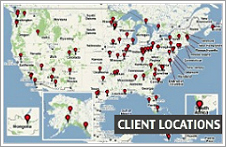You’ve come to the right place for buzzword-free info about work, workplaces, and workplace improvement. These posts are all about improving work processes, strengthening teamwork, sharpening management skills and leadership skills, improving communication, and more. This is info you can use right away, full of practical ideas in straight-talking plain English. Enjoy!
• Have a suggestion or question for a possible future post? Please let us know.
Here’s your secret to more success at work

If you’ve achieved any kind of success at work — and we know you have! — you can easily achieve more. All it takes is a thoughtful look back and an action-oriented look forward.
First, pick out one of your bigger successes from the work you’ve done in your current workplace.
It doesn’t have to be some Nobel Prize equivalent — just an accomplishment that rises high on your list of “very well done.”
Here are some wide-ranging examples to get you thinking:
You had a breakthrough conversation with your manager.
You assembled the perfect group for a given assignment.
You came up with an idea and carried it through to fruition.
You gave colleagues a new way to understand an old situation.
You made connections with people in other work units.
You helped a customer in a major way.
You took it upon yourself to attend training and use new skills.
Once you have a specific success in mind, think it through with these three prompts:
What was the very first thing you did to set in motion the chain of events that led to your accomplishment? Even though other people might have been involved, focus on yourself and what you did. Fill in the blank: I set things in motion by _____.
That first step is crucial. But what is one other thing you did that seemed essential to your success? Fill in the blank: Another key action on my part is that I _____.
What are you glad that you didn’t do in this situation? Fill in the blank: If I had _____, I never would have achieved this success.
Now step back and realize this: You played the key role in making this success happen. Other people might have helped, and the planets might have lined up in helpful ways, but your actions made the difference.
As for the specifics of what you did, think about your fill-in-the-blank responses. You had a past-tense mindset for this exercise, but turn forward now and look ahead. What do your answers tell you about how you should go about your work in the future?
Fill in the blank: I will achieve more success in the future as long as I _____.
Your answer is some of the best advice you’ll ever get. Put it to work starting now.
Broadcast success and you’ll get more of it

If you want to build a positive workplace culture, one of your best opportunities is available to you every day.
It’s so simple. Just pay attention to what’s going right, then call it out among colleagues.
There’s a lot to find, as long as you look: determined effort, great performance, a best practice, stellar results, compliments from a customer, the completion of a big project, and much more.
This is a must for all managers. But anyone in any organization can do this, and everyone should. Here’s how:
Begin every meeting by citing recent accomplishments.
Have colleagues chime in with their own positive observations.
Make a habit of expressing thanks — and give the gratitude more magnitude by telling the person exactly what they did that made a positive difference.
Put several success stories in each issue of your internal newsletter or e-letter.
In one-on-one conversations, become a positive gossip, sharing a story or two that illustrates what’s going right in the workplace.
Do this on a regular basis, so it becomes a part of the everyday routine.
As all this good news get circulated, confidence will grow. People will learn and improve as they hear about factors that led to success. They’ll follow your lead and share their own positive testimonials. Even the skeptics and naysayers will start to find silver linings.
Over time, you’ll get more of what you want in the workplace. The workplace culture will strengthen from the inside out.
The catch? You have to get it started.
This one word can change everything

Most workplace conversations have to do with what we’re doing. Or how we’re doing it. Or who, when, or where.
What’s missing is why.
With why questions, you rarely have easy answers. That’s what makes them so powerful. A good why can open the way to crucial discovery.
Here are some examples:
Why are we in business?
Why are we doing it this way?
Why can’t we do it this other way?
Why don’t we get together with staff from ___?
Why do people work here?
Why would someone want to work here?
Why was last year our best (or worst) year?
Why do our customers pick us?
Why does everyone else pick someone else?
When used with skill and persistence, the word why is like mining equipment. It can help you dig deep and find rich insights.
Take that first question: Why are we in business? When people keep digging with one why after another, they can tap into a meaningful mission.
Even when nothing good is uncovered, that can be an important discovery in its own right. It can prompt a rethinking that leads to major improvement.
It’s worth noting that this type of mining does not require special training or certifications. Keep that in mind the next time your colleagues are stuck on the surface with what and how.
You can multi-do, but can you multi-think?
 For the next 10 seconds, picture a pine tree swaying side to side in a gentle breeze. See it in your mind.
For the next 10 seconds, picture a pine tree swaying side to side in a gentle breeze. See it in your mind.
Now picture a junk yard full of wrecked vehicles. They’re smashed into towers of rusted metal. You can see that too, right?
Now try to see both images at the same time. Keep trying.
Not so easy, eh? For those of us who have one brain, it’s impossible.
At best, we can switch our thoughts from one image to another. But that’s not the same as having two trains of thought running on the same track at the same time.
The fact is, whether we’re talking about pine trees or junk yards or work-related data or a customer issue or that latest team project, we can consciously apply our ample brainpower to only one thing at a time.
So when it comes to multi-tasking, we can multi-do but we can’t multi-think. We can stay in motion, but it won’t be informed motion.
This isn’t a problem when you multi-task on easy activities that call for little if any thinking. Go ahead and juggle to your heart’s content.
But when your work calls for creativity or analysis or logic or evaluation or empathy or awareness or pretty much anything else where brainpower matters, opt for single-tasking.
Your mind will serve you better, your results will be greater, and you will ultimately get more done more quickly.
A week that will make your workplace strong
 “Casual Day” is now the norm in many workplaces. It’s typically on Friday, which got me thinking about the rest of the week. Why can’t we dedicate the other days in even better fashion?
“Casual Day” is now the norm in many workplaces. It’s typically on Friday, which got me thinking about the rest of the week. Why can’t we dedicate the other days in even better fashion?
“Learning Thursday” would be just that — a day to learn something about anything that’s remotely related to work-related. Each person or team would have to initiate their own learning, but it doesn’t have to be complicated. We’re talking five minutes to have a colleague explain how the accounts are processed. Or asking the resident expert for tips on how to use that new machine. Or getting with colleagues to share your best proven practices for doing certain aspects of your job.
“Why Wednesday” affirms the importance of critical thinking. At least once during the day, people are to ask “why” when they find themselves doing the same thing in the same way for no good reason. “Why are we filing away these forms that no one ever uses?” “Why am I checking my email ten times a day when once or twice would be plenty?” “Why haven’t I walked over to accounting to meet and talk with my contact there in person, instead of my usual drill of sending him yet another email?” All good questions.
“Customer Tuesday” puts the attention on customers. True, we should be serving them well every day, but how about one day a week when we’re expected to reach out and ask them directly for feedback. Each person would contact at least one of their internal or external customers, to see whether they’re thrilled and to get at least one actionable insight or improvement idea.
“Acknowledgment Monday” is about recognizing what’s going right and who’s doing great things at work. Each person would make a point of finding at least one positive — and calling it out to colleagues. Maybe it’s a newly improved process that’s making life easier for everyone. If so, say so. Maybe it’s someone on your team whose service ethic has them always helping out. If so, let them know they’re appreciated. Or maybe it’s just a silent acknowledgment inside — appreciation for a job and colleagues and the chance to serve, even if there are things we’d like to change.
Last but not least, let’s institutionalize the “No-Work Weekend,” setting aside one or two days each week as a completely work-free zone. No working on work, no thinking about work, no talking about work, no worrying about work. We can’t enforce such a thing, but that shouldn’t stop us from trying.
(On a much lighter note, some other possibilities come to mind: Comedic Monday, No-Talk Tuesday, Web-Surf Wednesday, Rave-and-Rant Thursday, No-Show Friday. I’m kidding, mostly.)




